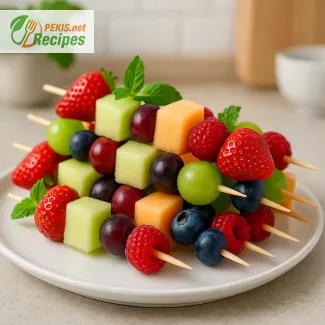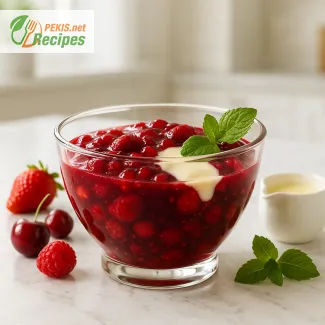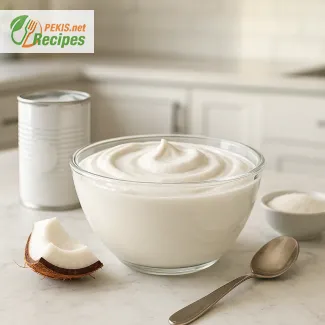
Easy Fruit Kabobs with Melon, Grapes and Berries for Summer Parties
A colorful, refreshing, and crowd-pleasing treat perfect for warm weather celebrations
There’s something undeniably joyful about vibrant, fresh fruit skewered into neat little kabobs. They are playful, portable, and utterly irresistible—especially when juicy melon, crisp grapes, and sweet summer berries come together in one delicious bite. These easy fruit kabobs are the kind of treat that pleases both the eye and the palate, making them a go-to option for summer parties, picnics, brunches, or even elegant dessert tables at weddings and baby showers.
In a world full of complicated desserts and sugary overindulgence, fruit kabobs offer a healthy, naturally sweet alternative that still feels indulgent. The combination of textures and flavors—from the soft honeydew to the snap of green grapes and the burst of ripe strawberries—creates a balance that is refreshing and satisfying. What makes this recipe especially appealing is its simplicity. With just a few fresh ingredients and minimal prep time, you can create a platter that looks gourmet but requires no culinary degree to assemble.
These kabobs are also endlessly versatile. You can stick to the classic trio of melon, grapes, and berries, or adapt them based on what's in season or your guests' preferences. Whether served chilled on a hot day or arranged on ice for a sophisticated event, they remain visually stunning, nutrient-rich, and child-friendly. Their elegant presentation also makes them a smart option for hosts who want a dessert that’s both easy and impressive.
From a nutritional standpoint, this recipe delivers more than just flavor. Each skewer is packed with vitamins, antioxidants, and hydration, supporting overall wellness without added sugars or artificial ingredients. As more people seek light, clean, and plant-based dishes, fruit kabobs rise in popularity—not just as a diet-friendly choice but as a staple of modern entertaining.
Whether you’re catering to health-conscious guests or simply looking for a beautiful, no-fuss treat, these easy fruit kabobs with melon, grapes, and berries are your ticket to summer celebration success. With their vibrant color, refreshing taste, and effortless charm, they’re not just another fruit platter—they’re a centerpiece that captures the essence of the season.
Easy Fruit Kabobs with Melon, Grapes and Berries for Summer Parties
- Wash and dry all fruit thoroughly under cool water. Pat gently with a paper towel.
- Cut the melons into even-sized cubes of approximately 2.5 cm (1 inch). Remove any seeds.
- Trim the strawberries, removing the green tops. Leave them whole if small or halve them if large.
- Check grapes to ensure they are firm and seedless. Leave them whole.
- Gently toss the berries (blueberries and raspberries) with lemon juice to enhance their flavor and prevent browning.
- Assemble the kabobs by threading one piece of cantaloupe, one grape (green or red), one piece of honeydew, one strawberry, a few blueberries, and a raspberry onto each skewer. Alternate colors and textures for visual appeal.
- Arrange the skewers on a serving platter. Garnish with fresh mint leaves if desired.
- Serve immediately or cover and refrigerate for up to 4 hours before serving.
Creative Twists to Elevate Your Fruit Kabobs Recipe
Smart ingredient upgrades and preparation tips to make your fruit skewers unforgettable
When it comes to easy, fresh desserts, fruit kabobs are a timeless classic. They are naturally beautiful, healthy, and simple to prepare. But even such a straightforward recipe offers room for refinement and creativity. Enhancing a traditional dish is not about complicating it—it’s about understanding its structure and discovering ways to maximize its flavor, texture, and visual appeal. With a few thoughtful changes, you can transform basic fruit skewers into a culinary centerpiece that dazzles at any gathering.
Understanding the basics: what makes a great fruit kabob?
Fruit kabobs succeed when they strike a balance between sweetness, tartness, juiciness, and firmness. Their appeal is equally visual and gustatory. A well-composed skewer should include different colors, shapes, and textures, combining juicy melons with crisp grapes and soft berries. Uniform slicing, even spacing, and structural stability are essential for both presentation and practicality.
Yet many home cooks unknowingly miss out on elevating this simple treat by sticking to only what’s convenient or by skipping key preparation steps. With a deeper understanding of ingredients and techniques, you can go from making “just another fruit skewer” to offering a restaurant-quality platter.
Ingredient upgrades that elevate flavor and nutrition
Choose fruits at their peak ripeness
Selecting perfectly ripe fruit isn’t just about sweetness. It’s about texture, aroma, and color vibrancy. Melons that are underripe can be bland and dry, while overripe berries become mushy and fall apart on the skewer. Always check for fragrance and firmness. For example:
- Cantaloupe and honeydew should give slightly when pressed at the stem end and emit a sweet scent.
- Grapes should be plump and firmly attached to green stems.
- Strawberries should be bright red with fresh, green caps—no white at the tip.
- Blueberries and raspberries should have a deep color with a matte finish.
Using the best quality produce not only enhances taste but also boosts the nutritional profile of your kabobs, as fruits lose nutrients quickly when past their prime.
Introduce flavor layering with herbs and citrus
One easy way to add complexity is with fresh herbs and a hint of acid. A quick toss of the fruit in freshly squeezed lemon or lime juice brightens the flavors and prevents browning. Adding finely chopped mint or basil between fruit pieces can introduce subtle aromatic notes that turn an everyday treat into something extraordinary.
For example, placing a mint leaf between a grape and a strawberry adds a cooling, herbal note that balances sweetness. A sprinkle of lemon zest before serving can also lift the entire flavor profile.
Add creamy or crunchy contrast
Fruit kabobs are primarily juicy and soft, so introducing a creamy or crunchy element can provide contrast. Consider:
- Small cubes of feta or mozzarella for a savory-sweet pairing.
- Dusted crushed nuts like pistachios or almonds for a subtle crunch.
- A drizzle of yogurt-honey sauce or a dark chocolate dip on the side for richness.
These additions not only improve texture and flavor, but also expand the dish into a more satisfying snack or light meal.
Why homemade fruit kabobs are better
Creating fruit kabobs at home allows for control over freshness, hygiene, presentation, and customization. Pre-packaged skewers often contain fruits that have been pre-cut days in advance, compromising their flavor and texture. Moreover, store-bought kabobs rarely offer interesting combinations or garnishes.
Homemade kabobs give you the opportunity to:
- Use organic or local fruit for better taste and lower environmental impact.
- Cut the pieces uniformly, ensuring easier eating and aesthetic presentation.
- Personalize the combinations based on dietary preferences or seasonal availability.
You also avoid unnecessary packaging waste, added preservatives, and excess sugar, especially if buying from commercial sources that marinate the fruit in syrups.
Common mistakes and how to avoid them
Mistake: Mixing overly juicy fruits
Solution: Avoid using fruits like watermelon, which can leak and make the skewers soggy. If you do want to include them, place them at the ends to minimize dripping onto other pieces.
Mistake: Skewering soft fruits too early
Solution: Berries like raspberries and strawberries can lose their structure. Add them last or shortly before serving to maintain their shape and firmness.
Mistake: Uneven cutting or placement
Solution: Use a sharp knife and consistent cube size (ideally around 2.5 cm or 1 inch) to make skewering smooth and the final product stable. Alternate soft and firm fruits to prevent breakage and improve balance.
Health-conscious variations for a better lifestyle
Fruit kabobs are already a nutrient-dense alternative to processed desserts, but there are still ways to make them more aligned with dietary goals:
- Use low-sugar fruits like kiwi, blackberries, or citrus for diabetics or those watching sugar intake.
- Choose high-antioxidant fruits such as blueberries, raspberries, and pomegranate seeds to support skin and cellular health.
- For a protein-rich snack, serve with Greek yogurt dip spiced with cinnamon and honey.
Each modification can subtly affect the taste and purpose of the dish—making it either refreshingly tart, extra hydrating, or more filling, depending on the selected ingredients.
The power of presentation
Even the simplest ingredients can feel luxurious when presented well. Arrange your kabobs in a circular fan, stacked pyramid, or individual mason jars for grab-and-go convenience. Garnish with edible flowers, microgreens, or coconut flakes to create visual drama.
A thoughtful presentation increases the perceived value and enjoyment of the dish, making guests more likely to appreciate the effort—even when it only took 15 minutes.
Respect tradition, but don’t be afraid to innovate
Traditional recipes like fruit kabobs have endured because they work. But that doesn’t mean they can’t be improved or adapted to suit modern palates, health goals, and visual expectations. By upgrading ingredients, refining techniques, and adding personalized twists, you can transform a simple fruit skewer into a signature dish that’s both familiar and extraordinary. Let the recipe serve as a reliable foundation—and let your creativity do the rest.
Allergens present in the recipe:
- None (naturally allergen-free and gluten-free)
Suggestions for allergen and gluten replacement:
- No replacements needed. This recipe is naturally free of gluten, dairy, nuts, soy, and eggs. Ensure all ingredients are labeled gluten-free if contamination is a concern.
- Vitamin C – 68 mg: Supports immune system and collagen production.
- Vitamin A – 150 µg: Essential for vision and skin health.
- Folate – 40 µg: Important for DNA synthesis and cell repair.
- Potassium – 340 mg: Helps regulate blood pressure and fluid balance.
- Calcium – 25 mg: Supports bone health.
- Magnesium – 18 mg: Important for muscle and nerve function.
- Anthocyanins – 25 mg: Found in berries, support heart health and fight inflammation.
- Beta-carotene – 1.2 mg: From melons, promotes healthy skin and eyes.
- Resveratrol – 0.4 mg: Present in grapes, supports cardiovascular health.
- Vitamin E – 0.6 mg: Protects cells from oxidative stress.





